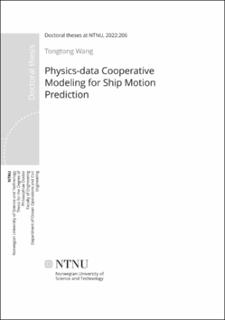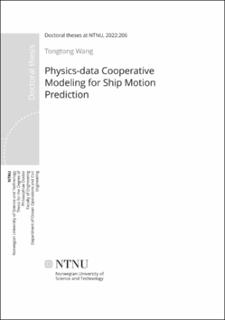| dc.contributor.advisor | Zhang, Houxiang | |
| dc.contributor.advisor | Æsøy, Vilmar | |
| dc.contributor.advisor | Li, Guoyuan | |
| dc.contributor.author | Wang, Tongtong | |
| dc.date.accessioned | 2022-07-15T10:54:32Z | |
| dc.date.available | 2022-07-15T10:54:32Z | |
| dc.date.issued | 2022 | |
| dc.identifier.isbn | 978-82-326-5633-2 | |
| dc.identifier.issn | 2703-8084 | |
| dc.identifier.uri | https://hdl.handle.net/11250/3005726 | |
| dc.description.abstract | Increasing development on autonomous vehicles and concern on ship navigation safety put forward a higher requirement for ship motion forecasting technology. The predictions of ship motion in the near future can give the operator (autonomous ship operating system or human) ample time to respond and avoid dangerous operations. Therefore, modeling and predicting the behavior of ships have been pursued extensively to enhance state estimation and motion control. Vessels operating on the surface of the ocean are exposed to an array of uncertainties, such as the external perturbations produced by wind, waves, and sea currents, etc. Creating an advanced model that comprehensively represents the system and its interaction with its immediate environments has always been challenging. Existing ship motion prediction approaches leverage a wide variety of modeling techniques. The dynamic models can propagate the estimated states into the future. Still, due to the nonlinearity, time-varying dynamics, and coupling with also time-varying environments, it is difficult to derive a good state estimator with high accuracy from observing and understanding the complex system. The fast advancement in instrumentation and data analysis techniques offers an alternative solution by constructing end-to-end models based only on data sampled from ships. For the lack of physical interpretability and inspection of internal structure, these data-based models do not always meet the expectations. The new knowledge and technology to bridge the gap are in demand.
The physics-data hybrid concept is an approach of cooperation, differentiation, and maximizing the potential of both models. Either model offers partial solutions for the vessel system. To ensure optimal outcomes, different modeling principles are working in a cooperative way, which requires the capabilities of both segments to operate as efficiently as possible. Leveraging the speed and flexibility advantages of the data-driven technologies and ensuring the robustness and quality of the high-fidelity physics-based model, the cooperative modeling appears to provide fast and accurate predictions for offshore surface vessels.
This dissertation exploits the physics-data cooperative modeling methodology and contextualizes the synthesis in maritime motion prediction. In the hybrid framework, modeling principles and formats of fusion aligned differently at various operation scenarios. Three case studies are conducted to validate the developed physics-data cooperative models for optimization and prediction. The first one relates to physics-based disciplines and enabling applications. The rest deploy two forms of cooperation. Experiments are carried out in both simulator and the vessel R/V Gunnerus operating in the real world. The results confirm the enhanced mode quality and prediction performance observed for the physics-data cooperative models. | en_US |
| dc.language.iso | eng | en_US |
| dc.publisher | NTNU | en_US |
| dc.relation.ispartofseries | Doctoral theses at NTNU;2022:206 | |
| dc.relation.haspart | Paper 1:
Wang, Tongtong; Li, Guoyuan; Skulstad, Robert; Æsøy, Vilmar; Zhang, Houxiang.
An effective model-based thruster failure detection method for dynamically positioned ships. I: 2020 IEEE International Conference on Mechatronics and Automation. IEEE conference proceedings 2020 s. 898-904
https://doi.org/10.1109/ICMA49215.2020.9233745
Institusjonsarkiv:
https://hdl.handle.net/11250/2686009 | |
| dc.relation.haspart | Paper 2: Wang, Tongtong; Li, Guoyuan; Wu, Baiheng; Æsøy, Vilmar; Zhang, Houxiang. Parameter Identification of Ship Manoeuvring Model Under Disturbance Using Support Vector Machine Method. Ships and Offshore Structures 2021 ;Volum 16. s. 13-21 https://doi.org/10.1080/17445302.2021.1927600 This is an Open Access article distributed under the terms of the Creative Commons Attribution-NonCommercial-NoDerivatives License (CC BY-NC-ND 4.0) | |
| dc.relation.haspart | Paper 3: Wang, Tongtong; Li, Guoyuan; Hatledal, Lars Ivar; Skulstad, Robert; Æsøy, Vilmar; Zhang, Houxiang. Incorporating Approximate Dynamics Into Data-Driven Calibrator: A Representative Model for Ship Maneuvering Prediction. IEEE Transactions on Industrial Informatics 2021 ;Volum 18.(3) s. 1781-1789 https://doi.org/10.1109/TII.2021.3088404 Institusjonsarkiv: https://hdl.handle.net/11250/2825522 | |
| dc.relation.haspart | Paper 4:
Wang, Tongtong; Hatledal, Lars Ivar; Kanazawa, Motoyasu; Li, Guoyuan; Zhang, Houxiang.
Effect of Ship Propulsion Retrofit on Maneuverability Research Based on Co-simulation. I: Software Engineering and Formal Methods. SEFM 2021 Collocated Workshops. Conference proceedings © 2022. Springer 2022. s. 189-203
https://doi.org/10.1007/978-3-031-12429-7_14 | |
| dc.relation.haspart | Paper 5:
T. Wang, R. Skulstad, M. Kanazawa, G. Li, and H. Zhang, “Knowledge Transfer
Across Ships: Leveraging Trends to Enhance Grey-box Trajectory Prediction. | |
| dc.relation.haspart | Paper 6:
Wang, Tongtong; Skulstad, Robert; Kanazawa, Motoyasu; Li, Guoyuan; Æsøy, Vilmar; Zhang, Houxiang.
Physics-informed Data-driven Approach for Ship Docking Prediction. I: 2022 IEEE International Conference on Real-time Computing and Robotics (RCAR). IEEE conference proceedings 2022 ISBN 978-1-6654-6983-8. s. 111-117
https://doi.org/10.1109/RCAR54675.2022.9872179
© 2022 IEEE. Personal use of this material is permitted. Permission from IEEE must be obtained for all other uses, in any current or future media, including reprinting/republishing this material for advertising or promotional purposes, creating new collective works, for resale or redistribution to servers or lists, or reuse of any copyrighted component of this work in other works. | |
| dc.title | Physics-data Cooperative Modeling for Ship Motion Prediction | en_US |
| dc.type | Doctoral thesis | en_US |
| dc.subject.nsi | VDP::Teknologi: 500::Marin teknologi: 580 | en_US |

